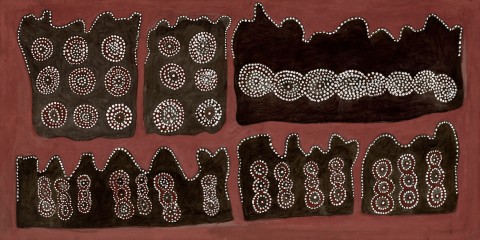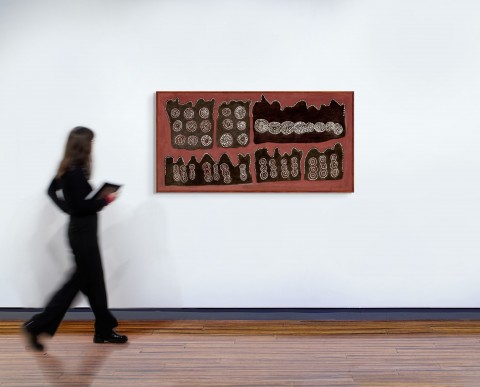JARLINJI (PLAINS KANGAROO), 1990
JACK BRITTEN JOOLAMA
natural earth pigments on canvas
80.0 x 160.0 cm
bears inscription verso: artist's name, size and Waringarri Aboriginal Arts cat. S-2921 and AP-3410
Waringarri Aboriginal Arts, Kununurra, Western Australia
Lindsay Street Gallery, Darwin
Private collection, New South Wales
Sotheby's, Melbourne, 26 July 2004, lot 130
Private collection, Sydney
Recent Works by the Artists of Warmun Community, Turkey Creek, Western Australia, Lindsay Street Gallery, Darwin, 1991, cat. 22
This work was originally sold with a copy of the original certificate of authenticity from Waringarri Aboriginal Arts which stated in part:
‘This painting shows Garndi country near Port Headland. It is a dreaming place where the plains kangaroo (Jarlinji) started out to travel to the Kija country when he was a man in the dreamtime. He came from the west right up to Turkey Creek. The north/south highway runs through the picture and the road is intersected by a railway line. On the western side of the road are large rocks or hills and on the eastern side (represented at the bottom of the painting) are lots of small rocks standing upright. The rocks are decorated with the sacred patterns belonging to the plains kangaroo'
Jack Britten (Joolama) painted sites of spiritual significance for the Gija across the East Kimberly; Purnululu, Woorreranginy, Tickelara, Spring Creek and the upper reaches of the Ord River. In Jarlinji, Plains Kangaroo, 1990, the roundels that decorate the rock surfaces depicted in the painting are based on body painting designs relating to the Jarliny or Jarlangarnany, the mythical Plains Kangaroo men. On their ancestral travels, four Jarliny men transformed into rocks when the last one of them looked back. A song about the Kangaroo translates as “They are all standing in a line on the mountain just like the reeds that grow in the water.”1
Ryan, J., ‘Bones of Country: The East Kimberley Aesthetic’, in Ryan, J., and Akerman, K., Images of Power: Aboriginal Art of the Kimberley, National Gallery of Victoria, Melbourne, 1993, p. 42


